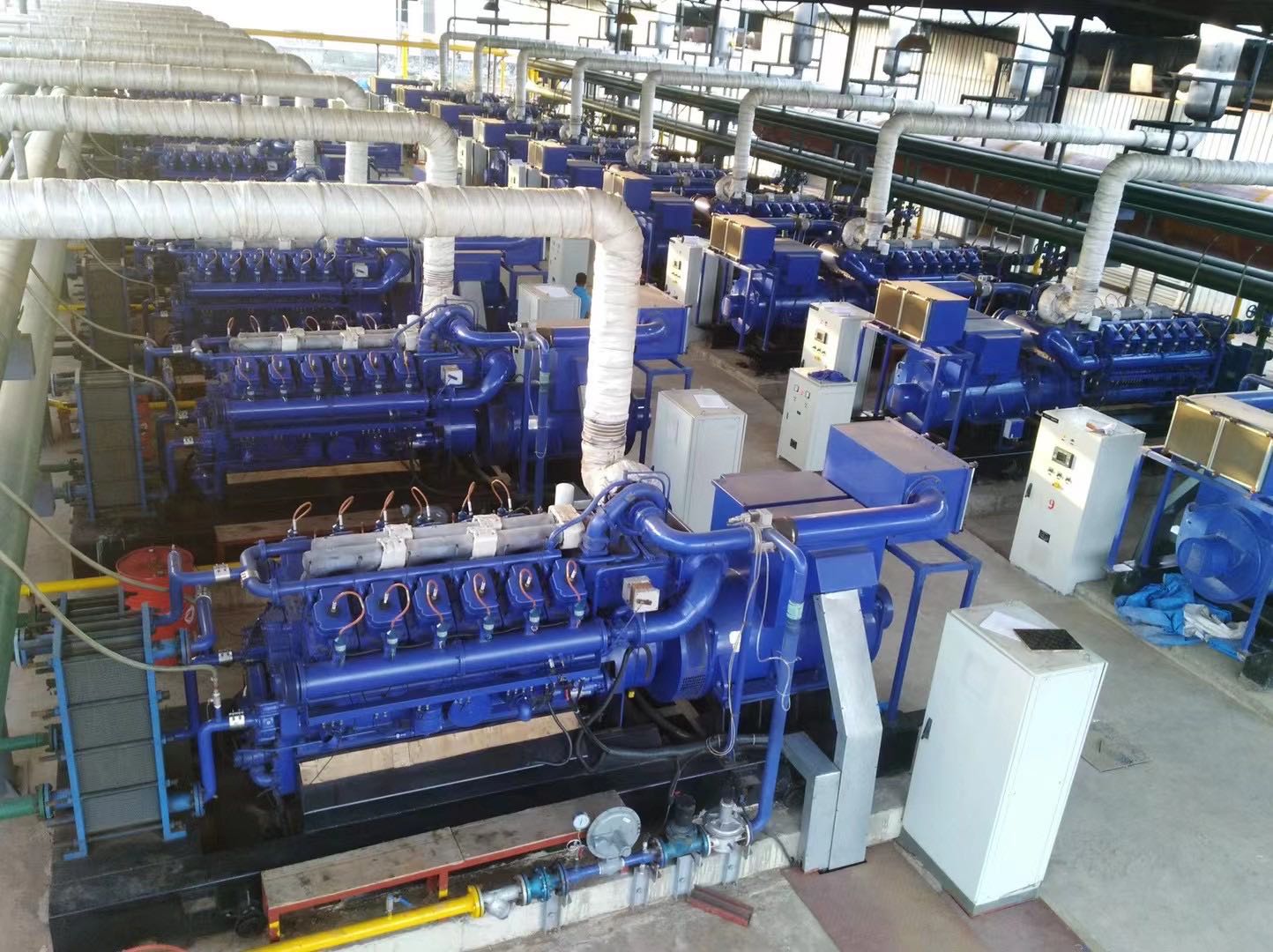 聯(lián)系 - 熱線
聯(lián)系 - 熱線
0531-69953988

 聯(lián)系 - 熱線
聯(lián)系 - 熱線
解析燃氣發(fā)電機組對燃料的需求
燃氣發(fā)電機組作為分布式能源系統(tǒng)的核心設備,其運行穩(wěn)定性與燃料品質(zhì)密切相關。燃料適配性不僅影響機組熱效率,更直接關聯(lián)設備壽命與排放達標率。本文從燃料成分、物理特性、雜質(zhì)控制三個維度,深度解析燃氣發(fā)電機組對燃料的嚴苛要求。
As the core equipment of distributed energy systems, the operational stability of gas-fired generator sets is closely related to fuel quality. The fuel adaptability not only affects the thermal efficiency of the unit, but also directly relates to the equipment life and emission compliance rate. This article deeply analyzes the strict requirements of gas generators for fuel from three dimensions: fuel composition, physical properties, and impurity control.
一、化學成分的黃金配比
1、 The golden ratio of chemical composition
燃氣發(fā)電機組對燃料化學成分的要求,本質(zhì)是燃燒學與材料科學的平衡藝術(shù)。以天然氣為例,甲烷含量需維持在70%-95%區(qū)間,這一范圍既保證燃燒熱值,又避免過高烷烴導致的積碳風險。當甲烷濃度低于65%時,燃燒室會出現(xiàn)火焰?zhèn)鞑ニ俣认陆怠⒈饍A向增加等異常工況,直接導致熱效率下降3%-5%。
The requirements of fuel chemical composition for gas generator sets are essentially the art of balancing combustion science and materials science. Taking natural gas as an example, the methane content needs to be maintained within the range of 70% -95%, which ensures the combustion heat value and avoids the risk of carbon deposition caused by excessive alkanes. When the methane concentration is below 65%, abnormal operating conditions such as a decrease in flame propagation speed and an increase in detonation tendency will occur in the combustion chamber, directly leading to a 3% -5% decrease in thermal efficiency.
硫化物控制是燃料適配的關鍵指標。硫化氫含量需嚴格控制在20mg/Nm2以下,該數(shù)值源自對發(fā)動機閥系材料的腐蝕試驗數(shù)據(jù)。當H2S濃度超標時,排氣閥座接觸面會出現(xiàn)蜂窩狀腐蝕,6個月內(nèi)即可導致密封失效。對于沼氣等生物質(zhì)燃氣,氨含量同樣需控制在20mg/Nm2以內(nèi),以防止硝酸鹽沉積引發(fā)的缸套磨損。
Sulfide control is a key indicator for fuel adaptation. The content of hydrogen sulfide must be strictly controlled below 20mg/Nm 2, which is derived from corrosion test data on engine valve system materials. When the concentration of H2 S exceeds the standard, honeycomb corrosion will occur on the contact surface of the exhaust valve seat, which can lead to seal failure within 6 months. For biomass gases such as biogas, the ammonia (NH3) content should also be controlled within 20mg/Nm2 to prevent cylinder liner wear caused by nitrate deposition.
二、物理特性的精密邊界
2、 Precise boundary of physical properties
燃料壓力穩(wěn)定性直接影響機組負荷響應速度。在0.08-0.30MPa的壓力窗口內(nèi),壓力波動率需≤1kPa/min。某型燃氣機組實測數(shù)據(jù)顯示,當壓力波動超過±10%時,渦輪增壓器喘振頻率提升40%,導致軸承潤滑油膜破裂風險增加。對于壓力波動超標場景,需配置雙聯(lián)穩(wěn)壓閥組,通過壓力反饋控制系統(tǒng)實現(xiàn)0.1秒級快速調(diào)節(jié)。
The stability of fuel pressure directly affects the load response speed of the unit. Within the pressure window of 0.08-0.30MPa, the pressure fluctuation rate should be ≤ 1kPa/min. The measured data of a certain type of gas turbine unit shows that when the pressure fluctuation exceeds ± 10%, the surge frequency of the turbocharger increases by 40%, leading to an increased risk of bearing lubricating oil film rupture. For scenarios where pressure fluctuations exceed the standard, a dual regulator valve group needs to be configured to achieve rapid adjustment in 0.1 seconds through a pressure feedback control system.
溫度控制存在雙重閾值:供氣溫度需≥5℃以防止管路結(jié)冰,同時要求燃料過熱度≥11℃以避免液態(tài)烴冷凝。在北方冬季工況中,需在燃料管路設置電伴熱系統(tǒng)與氣液分離器,確保燃料以氣態(tài)進入燃燒室。某垃圾填埋氣發(fā)電項目曾因未設置加熱裝置,導致燃料在調(diào)壓閥處結(jié)冰,造成機組非計劃停機。
There is a dual threshold for temperature control: the gas supply temperature must be ≥ 5 ℃ to prevent pipeline icing, and the fuel superheat must be ≥ 11 ℃ to avoid liquid hydrocarbon condensation. In winter working conditions in the north, it is necessary to install an electric heat tracing system and a gas-liquid separator in the fuel pipeline to ensure that the fuel enters the combustion chamber in gaseous form. A landfill gas power generation project once had an unplanned shutdown of the unit due to the lack of heating devices, resulting in fuel freezing at the pressure regulating valve.

三、雜質(zhì)控制的納米級標準
3、 Nano level standards for impurity control
固體顆粒物控制達到微米級精度,要求顆粒直徑<5μm且總含量≤30mg/Nm2 。這源于對噴油嘴孔徑的適配性要求——現(xiàn)代燃氣機組噴油嘴孔徑已縮小至0.15mm,大于5μm的顆粒會直接堵塞噴孔。某油田伴生氣發(fā)電項目因未設置高效過濾器,導致3個月內(nèi)噴油嘴更換頻率達2次/周,運維成本激增300%。
Solid particulate matter control achieves micrometer level accuracy, requiring particle diameter<5 μ m and total content ≤ 30mg/Nm 2 . This is due to the requirement for adaptability of the nozzle aperture - the nozzle aperture of modern gas turbine units has been reduced to 0.15mm, and particles larger than 5 μ m will directly block the nozzle aperture. Due to the lack of high-efficiency filters in a certain oilfield associated gas power generation project, the frequency of fuel injector replacement reached 2 times per week within 3 months, resulting in a 300% increase in operation and maintenance costs.
液態(tài)雜質(zhì)處理需構(gòu)建三級防護體系:初級分離器去除游離水,精密過濾器攔截乳化液,最后通過聚結(jié)過濾器實現(xiàn)油水分離。對于焦爐煤氣等含焦油燃料,需增設活性炭吸附裝置,將焦油含量控制在50mg/Nm2 以下。某鋼鐵企業(yè)案例顯示,焦油含量超標會導致渦輪葉片結(jié)焦,使機組出力下降15%僅需200小時。
The treatment of liquid impurities requires the construction of a three-level protection system: a primary separator to remove free water, a precision filter to intercept emulsion, and finally, oil-water separation is achieved through a coalescence filter. For tar containing fuels such as coke oven gas, it is necessary to install activated carbon adsorption devices to control the tar content below 50mg/Nm 2 . A case study of a certain steel enterprise shows that excessive tar content can cause coking of turbine blades, resulting in a 15% decrease in unit output in just 200 hours.
四、特殊燃料的技術(shù)適配
4、 Technical adaptation of special fuels
面對沼氣、煤層氣等非常規(guī)燃料,需進行專項技術(shù)適配。沼氣發(fā)電需配置雙膜儲氣柜,通過生物脫硫?qū)2 S含量降至200mg/Nm2 以下,同時設置焦油裂解裝置處理含有的復雜有機物。煤層氣發(fā)電則需解決低熱值難題,通過預混燃燒技術(shù)將熱值4.2MJ/Nm2 的燃料穩(wěn)定燃燒,某型機組已實現(xiàn)3.8MJ/Nm2 極限工況運行。
Special technical adaptation is required for unconventional fuels such as biogas and coalbed methane. Biogas power generation requires the installation of double membrane gas storage tanks, which can reduce the H 2 S content to below 200mg/Nm 2 through biological desulfurization. At the same time, a tar cracking device should be set up to treat complex organic compounds. Coalbed methane power generation needs to solve the problem of low calorific value. By using premixed combustion technology to stably burn fuel with a calorific value of 4.2MJ/Nm2 , a certain type of unit has achieved maximum operating conditions of 3.8MJ/Nm2 .
燃料適配性技術(shù)正在向智能化方向發(fā)展。某企業(yè)開發(fā)的燃料品質(zhì)在線監(jiān)測系統(tǒng),可實時檢測CH2 、H2 S、顆粒物等12項指標,通過邊緣計算調(diào)整空燃比,使機組在燃料品質(zhì)波動20%時仍保持額定出力。這種技術(shù)突破,為生物質(zhì)氣化發(fā)電等波動性場景提供了解決方案。
Fuel adaptability technology is developing towards intelligence. The fuel quality online monitoring system developed by an enterprise can detect 12 indicators such as CH 2 , H 2 S, and particulate matter in real time, and adjust the air-fuel ratio through edge computing, so that the unit can still maintain its rated output when the fuel quality fluctuates by 20%. This technological breakthrough provides a solution for volatile scenarios such as biomass gasification power generation.
本文由燃氣發(fā)電機組友情奉獻.更多有關的知識請點擊:http://m.newsletterv.cn我們將會對您提出的疑問進行詳細的解答,歡迎您登錄網(wǎng)站留言.
This article is a friendly contribution from the analysis of gas generator sets For more information, please click: http://m.newsletterv.cn We will provide detailed answers to your questions. You are welcome to log in to our website and leave a message
業(yè)務分類
Business classification產(chǎn)品推薦
product recommendation聯(lián)系方式
Contact Information
聯(lián)系我們
contact us
 咨詢電話:0531-69953988
咨詢電話:0531-69953988 公司地址:中國(山東)自由貿(mào)易試驗區(qū)濟南片區(qū)孫村街道經(jīng)十東路33688號章錦綜合保稅區(qū)聯(lián)東U谷科創(chuàng)中心5號樓101
公司地址:中國(山東)自由貿(mào)易試驗區(qū)濟南片區(qū)孫村街道經(jīng)十東路33688號章錦綜合保稅區(qū)聯(lián)東U谷科創(chuàng)中心5號樓101
關注公眾號

企業(yè)二維碼

截屏,微信識別二維碼